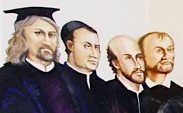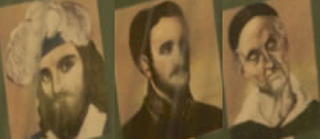
Henry Garnet, sometimes Henry Garnett, was an English Jesuit priest executed for high treason, based solely on having had advanced knowledge of the 1605 Gunpowder Plot and having refused to violate the Seal of the Confessional by notifying the authorities. Born in Heanor, Derbyshire, he was educated in Nottingham and later at Winchester College before he moved to London in 1571 to work for a publisher. There he professed an interest in legal studies and in 1575, he travelled to the continent and joined the Society of Jesus. He was ordained in Rome some time around 1582.

The Forty Martyrs of England and Wales or Cuthbert Mayne and Thirty-Nine Companion Martyrs are a group of Catholic, lay and religious, men and women, executed between 1535 and 1679 for treason and related offences under various laws enacted by Parliament during the English Reformation. The individuals listed range from Carthusian monks who in 1535 declined to accept Henry VIII's Act of Supremacy, to seminary priests who were caught up in the alleged Popish Plot against Charles II in 1679. Many were sentenced to death at show trials, or with no trial at all.
Mark Barkworth was a Catholic priest and martyr.

Nicholas Owen, S.J., was an English Jesuit lay brother who was the principal builder of priest holes during the reigns of Queen Elizabeth I and James I of England. Owen built many priest holes in the buildings of English Catholics from 1588 until his final arrest in 1606, when he was tortured to death by prison authorities in the Tower of London. Owen is honoured as a martyr by the Catholic Church and was canonized by Pope Paul VI in 1970.

William Ireland was an English Jesuit and martyr from Lincolnshire. He was falsely accused of conspiring to murder King Charles II during the Popish Plot hysteria, and was executed on 24 January 1679. He was beatified in 1929 by Pope Pius XI and his feast day is celebrated on 24 January, the day of his death.
Henry Foley, S.J. was an English Jesuit Roman Catholic church historian.

Polydore Plasden (1563–1591) was one of the Catholic Forty Martyrs of England and Wales. A native of London, he studied for the priesthood at Rheims and Rome and was ordained in 1586 before being sent back to England soon after.
Robert Nutter was an English Catholic priest, Dominican friar and martyr. He was beatified in 1987.

Ralph Corbie was an Irish Jesuit. He is a Catholic martyr, beatified in 1929.
Ralph Crockett was an English Roman Catholic priest. He is a Catholic martyr, beatified in 1929.
William Andleby (Anlaby) was an English Roman Catholic priest. He is a Catholic martyr, beatified in 1929.

Edward Oldcorne alias Hall was an English Jesuit priest. He was known to people who knew of the Gunpowder Plot to destroy the Parliament of England and kill King James I; and although his involvement is unclear, he was caught up in the subsequent investigation. He is a Roman Catholic martyr and was beatified in 1929.

George Napper (Napier) was an English Roman Catholic priest. He is a Catholic martyr, beatified in 1929 by Pope Pius XI.

Christopher Robinson was an English Catholic priest and martyr, beatified in 1987.

Hindlip Hall is a stately home in Hindlip, Worcestershire, England. The first major hall was built before 1575, and it played a significant role in both the Babington and the Gunpowder plots, where it hid four people in priest holes. It was Humphrey Littleton who told the authorities that Edward Oldcorne was hiding here after he had been heard saying Mass at Hindlip Hall. Four people were executed and the owner at that time barely escaped execution himself due to the intercession of Lord Monteagle.
Humphrey Littleton, or Humphrey Lyttelton, was a member of the Lyttelton family, who was executed for his involvement in the Gunpowder plot. Robert Wintour and Stephen Littleton who had escaped from the fight at Holbeche House were captured at Hagley Park on 9 January 1606 despite Littleton's protests that he was not harbouring anyone. It was Littleton who told the authorities that Edward Oldcorne was hiding at Hindlip Hall after he had given him mass. Wintour, Oldcorne, and both Littletons were all executed.

The Oaten Hill Martyrs were Catholic Martyrs who were executed by hanging, drawing and quartering at Oaten Hill, Canterbury, on 1 October 1588. The gallows had been put up in 1576. These four were beatified by Pope Pius XI in 1929.

John Carey was martyred at Dorchester, Dorset, England for adherence to the Roman Catholic faith. His feast day is 4 July.
Edward Thwing was an English Catholic priest and martyr.












